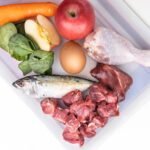Food allergies in dogs can lead to a range of uncomfortable symptoms, from skin irritations to gastrointestinal distress. Identifying and eliminating food allergens is crucial for your dog’s comfort and health. This process, often referred to as an elimination diet, requires patience, precision, and close observation. Let’s explore how you can effectively identify food allergens affecting your dog and strategies for creating a diet that keeps them happy, healthy, and allergy-free.
Understanding Food Allergies in Dogs
Food allergies occur when a dog’s immune system mistakenly identifies a specific food ingredient as harmful, triggering an allergic reaction. Common allergens include proteins commonly found in beef, dairy, wheat, chicken, egg, soy, and corn. Symptoms can vary widely but often include itching, skin rash, ear infections, vomiting, diarrhea, and excessive licking.
Step 1: Consult Your Veterinarian
The first step in addressing potential food allergies is to consult with your veterinarian. They can help rule out other causes of your dog’s symptoms and guide you through the process of an elimination diet. In some cases, they may recommend allergy testing, though it’s worth noting that testing for food allergies can be challenging and is not always definitive.
Step 2: Implementing an Elimination Diet
An elimination diet involves feeding your dog a diet with a limited number of ingredients that they have never eaten before. This typically means:
- Selecting a Novel Protein and Carbohydrate: Choose a protein and carbohydrate source your dog has not been exposed to before. Examples of novel proteins include venison, duck, or kangaroo. For carbohydrates, options might include sweet potatoes or peas.
- Strict Diet Adherence: During the elimination diet, it’s crucial to feed only the selected foods and avoid any treats, flavored medications, or table scraps that could contain the allergen.
- Duration: The elimination diet should be followed strictly for at least 8-12 weeks to accurately assess whether symptoms improve.
Step 3: Monitoring and Recording Symptoms
Keep a detailed diary of your dog’s symptoms, diet, and any incidental exposure to other foods. Note any changes in symptoms, both improvements and any flare-ups, to help identify potential allergens.
Step 4: Reintroducing Foods
If your dog’s symptoms improve during the elimination diet, the next step is to gradually reintroduce other foods one at a time to identify the allergen. Introduce one ingredient every two weeks, monitoring closely for any signs of an allergic reaction. If symptoms return, you’ve likely identified the allergen, and that food should be permanently removed from your dog’s diet.
Creating an Allergen-Free Diet
Once you’ve identified the allergens, you can create a balanced diet that avoids these triggers. This might involve:
- Commercial Hypoallergenic Diets: Many high-quality commercial dog foods are formulated to be hypoallergenic and can be a convenient option.
- Home-Cooked Meals: Preparing your dog’s meals at home allows for complete control over the ingredients. However, consult with a veterinarian or canine nutritionist to ensure the diet meets all your dog’s nutritional needs.
Tips for Success
- Patience is Key: Identifying food allergens can be a lengthy process, requiring patience and dedication.
- Communicate with Your Vet: Regular check-ins with your veterinarian can help adjust the elimination diet as needed and ensure your dog’s health is closely monitored.
- Avoid Cross-Contamination: Be vigilant about preventing your dog from accessing other food sources that might contain the allergen.
Conclusion
Identifying and eliminating food allergens from your dog’s diet can significantly improve their quality of life. Although the process requires effort and vigilance, seeing your dog happy, healthy, and symptom-free makes it worthwhile. Always work closely with your veterinarian to ensure a safe and effective approach to managing your dog’s food allergies.

























